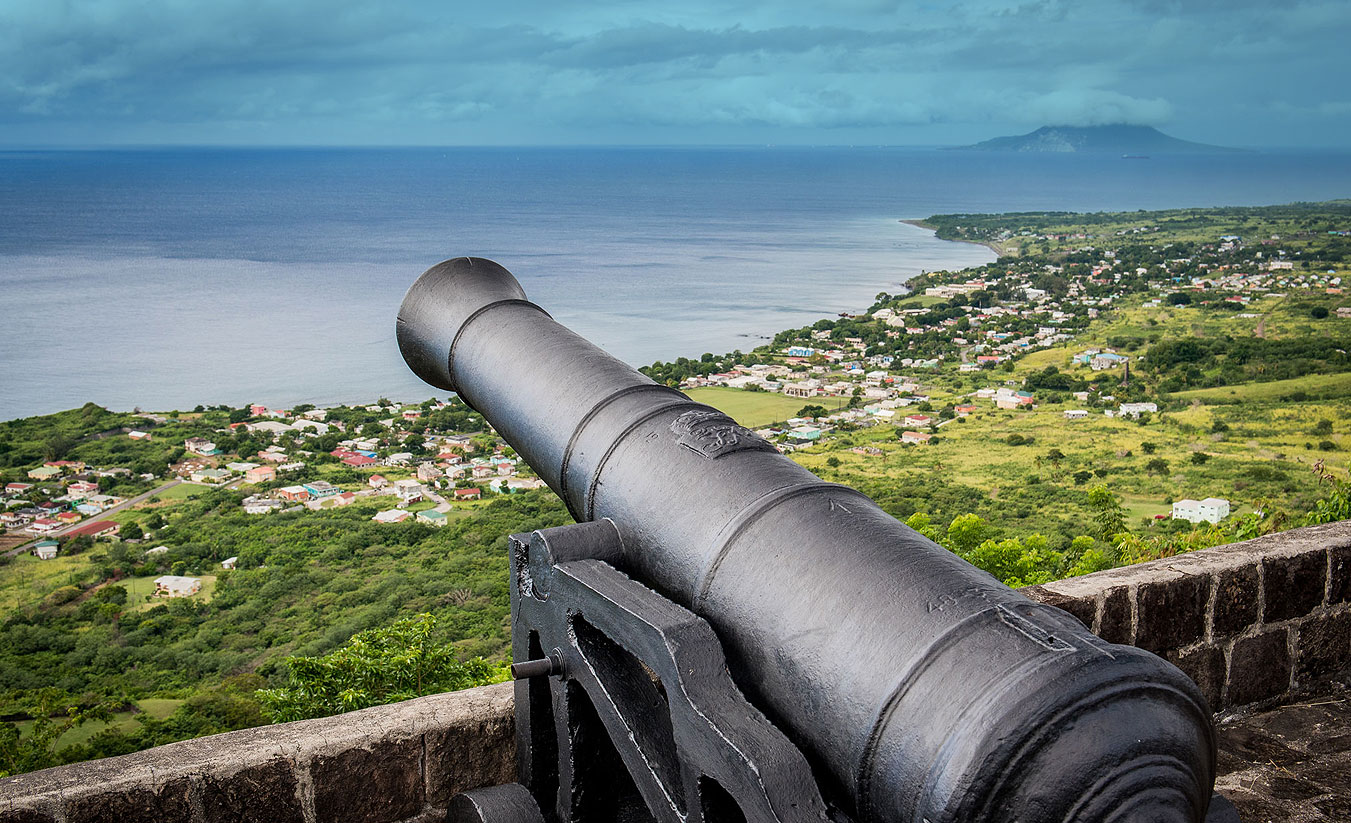The Circus
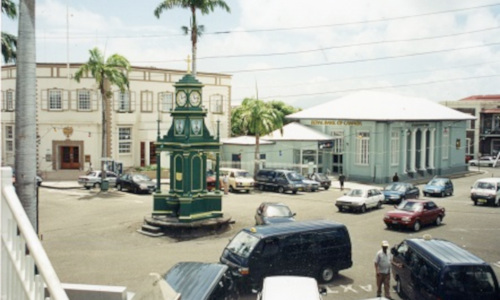
The Circus is the hub of Basseterre. It is a recognised landmark and a popular meeting place. The Circus owes its origins to the fire that destroyed Basseterre on July 4th, 1867. The whole town east of West Square street was devastated. The inefficiencies of the fire department were, at least in part, responsible for the magnitude of the disaster. When Basseterre was rebuilt, it was decided to make its streets easier for the fire truck to navigate. Among the new arrangements were the widening of Fort Street and the laying down of the Circus. In 1883 a memorial to Thomas Berkeley was placed at its centre. Because it contained a fountain and a clock, and it was erected on a platform which quickly became a seating area, it encouraged the gathering of people in the Circus.
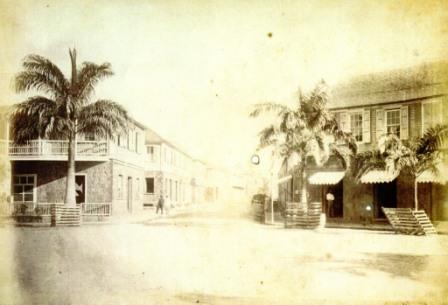
Circus 1877
St. George’s Anglican Church
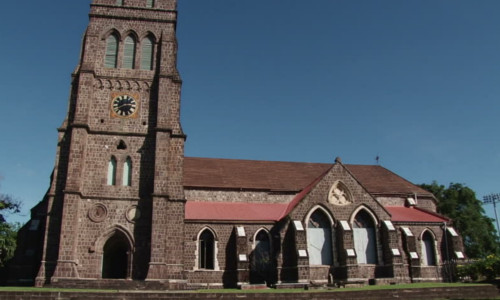
ST. GEORGE’S ANGLICAN CHURCH is the largest church in Basseterre. It stands at the head of Church Street and resembles an English parish church in style. The outer walls are of heavy andesite rock and the roof is covered in slate. Like many of the buildings in Basseterre this church has had its ups and downs, often rising from ashes like the mythical Phoenix.
In 1635, at the request of the directors of the Company of the Isles of America, the Provincial of the Capuchin Friars of Normandy assigned three men, Fathers Jerome, Marc and Pacifique de Provins to care for the spiritual needs of the French colonists on St. Kitts and to attempt the conversion of the small Kalinago population that remained on the island after the massacre of 1627. In Basseterre they erected a place of worship which Rochefort describes as a fair Church able to contain a very great Congregation: The Structure is of wood, rais'd on a foundation of Free-stone: Instead of Glass-windows there are only turned Pillars, after the fashion of a Balcony. It is cover'd with red Slate. The Friars also had churches in Cayon and Capisterre but in 1646, Governor De Poincy felt that they were taking sides against him and ordered them to leave the colony. He replaced them with the Jesuits. In 1672 they built a church which they called Notre Dame.
The wars that ravaged St. Kitts well into the 18th century caused destruction everywhere. Even the churches were not spared.
In 1706 while Col. Garnett was examining the cannon left at waterside at Basseterre, the Church there was sett on fire in the roof, he believed by some of his detachment of horse. (Calendar of State Papers Colonial, America and West Indies, v. 23: 1706-1708 (1916), pp. 68-89)
John Anderson arrived in St. Kitts in 1719 to take charge of the Parish of Trinity. He was also given responsibility for the care of Basseterre which was still not recognised as a parish. In a letter dated 15 July 1720 he wrote:
The church at Basseterre in the French times is said to have been one of the fairest and best in all the West Indies and it appears to have been so from the walls and ruin yet remaining. But upon our taking the island from them this church was burned down by some unfortunate chance or other and in all appearance will never be rebuilt without a contribution from England.
In a letter of the 22nd April 1721 he explained how he was holding services in town:
Our place of worship at Basseterre is only a common hired house and is not large enough for a third part of our people and so exceedingly hot when crowded, by reason of its ill situation and the lowness of the roof, that many persons faint away and are forced to be removed in the midst of the public worship.
St. Georges became a Parish in 1723 but Anderson was not appointed its first rector as he had quarreled with the administration after he refused to give communion to the Governor of Montserrat who was in a very open adulterous relationship. The first rector was John Beronville who took charge in 1733 and continued to care for the parish till 1765. Some time later the church was made fit for worship but in 1772 a devastating hurricane destroyed part of the roof and in 1776 St. George’s was again damaged by fire. An earthquake in 1842 and another hurricane in 1843 reduced the church to ruins. The following year the construction of a new building was started to the east of the old church. A number of internal disagreements in the Vestry and public dissatisfaction with the location of the new church brought work to a halt. Finally construction of the new place of worship was started in 1856 and on the 25th March 1858 it was consecrated by Bishop of Antigua. Designed by William Salter, the church was a massive stone building that could accommodate at least a thousand worshippers. Slater had also designed the furniture and fittings. The stained glass windows were produced by Clayton and Bell. At the time this was a new company but it went on to become one of the most prolific and proficient firms of English stained glass manufacturers. The one installed in the north-eastern extremity in 1861 was dedicated to Daniel Gateward Davis the first Bishop of Antigua, who had previously served as rector of St. George's, Basseterre.
A destructive fire took its toll on the town on the night of the 2nd July 1867, It broke oot in a bakery on the corner of Central and West Independence Square Street spreading quickly to the west as far as Salt Pond Alley. From there it turned north and made its way along Cayon Street a far as the Prison. St. George’s was completely destroyed. Immediately an appeal for contributions was circulated in Britain and the Caribbean. It was estimated that rebuilding would cost £6,000. The new furnishings were to be less elaborate than the ones destroyed in the fire. The island administration agreed to match the sums raised through voluntary contributions. The work of reconstruction started soon after.
As long as the structure could support a bell, this could have been used as a warning of imminent danger, such as fire or invasion. In the 19th century the bell became another means of repressing the life of the enslaved. The law would not allow enslaved persons without special passes to be on the streets after 10.00pm. From the 4th November 1822, the bell of St. George's was to be rung at 9.00pm every night as a warning that those enslaved persons who were still about, to return to where they lived within the hour.
In 1870 an organ was commissioned from the firm of Booth of Wakefield. Henry Booth planned and designed the instrument. In 1872 it was dismantled in preparation for shipping to St. Kitts. It was placed on the Ruckers, a cargo vessel. Booth arrived in St. Kitts on the 2nd February 1872. Following his first visit to the church he noted that it was of good size but that it had hardly any glass. The windows were shuttered to keep out the sun and let in the breeze. The place assigned for the organ was very much to his satisfaction.
The packages containing the organ arrived in St. Kitts in March 1872. Salt water had caused considerable damage and rats had eaten out much of the leather that covered some of the parts. A great deal of repair had to be done before the instrument could be installed. The organ was played for the public for the first time on the 16th May 1872. After Booth’s departure, Joseph Grimes maintained the organ for many years and he and members of his family played it for the congregation well into the 1930s. Marie Grimes was succeeded by Elaine Matheson (1937), Leighton Warner (1957), Eugene Bowrin and Velma Vivien Gumbs (1976). There is no full time organist at present.
Through the 20th century the church was lovingly looked after by the congregation it served. In 1956 a Lady Chapel was placed on the northern side of the Chancel and a Sacristy was build on to the church. On the 8th October 1974, St. George’s sustained damage from a severe earthquake that shook the Leeward Islands. The repairs were affected immediately by the English company of Higgs and Hill then engaged in the expansion of the airport.
Also involved in the work of repairing St. Georges and the other Anglican churches around the island rested in the hands of Lionel A. J. Trotman. He was again engaged to provide an estimate for the repair of the roof in 1984 but continued to be involved in the project right up to its completion and at no cost to the church.
Archdeacon Rudolph Smithen raised funds and also procured a loan from the United Society for the Propagation of the Gospel which made possible the replacement of the roof shingles, the wooden floor and the pews of the centre aisle.
In 1986, St. George’s was rededicated. The ceremony took place on the 10th November, one day after the Mount Olive Masonic Lodge had celebrated its 150th anniversary. Several members of the congregation were involved in the Lodge and its premises was for many years the venue of the church’s annual bazaar.
In 1989 Hurricane Hugo caused damage to the clock and the stairway in the church tower. Church funds, government support and a grant for World Heritage helped to effect some repairs. In 2007 once again rehabilitation work was done on the clock and the stairs.
St. George’s has been the venue of many ceremonies that impacted the nation. In 1978 it was the venue for the requiem mass for Robert Bradshaw, first premier of St. Kitts-Nevis and Anguilla and in 1979 of the state funeral of his successor, C.A. Paul Southwell took place there.
Today St. George’s continues to stand proudly at the head of Church Street and is home to the many Anglican worshipers who live in that parish as well as the location for the annual multi-denominational Concert of Christmas Songs.
Masses House
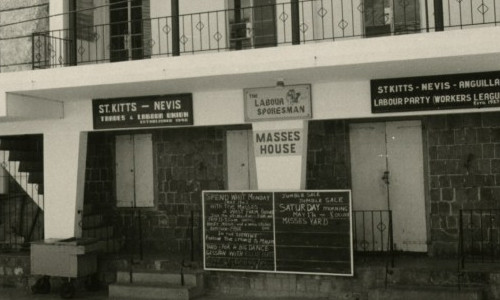
The Workers League was formed in 1932 and in 1940 its members also formed the St. Kitts-Nevis Trades and Labour Union. Meetings often took place at the building of the Mutual Improvement Society. All three organisations had members in common. Less formal meetings often took place in private residences or at business belonging to the membership. However the activities of the Union worried some of the members of the MIS and both the League and the Union were told to find other accommodation. Charles Halbert came to their rescue and offered them a space in his book shop which was then located on Church Street. However when that building was turned into the Blakeney Hotel, the two organisation were once again without a meeting place.
In 1947, a property on the western side of Church Street belonging to a Mrs. H Archibald came on the market. The Executive of the St. Kitts-Nevis Trades and Labour Union, long accustomed to meeting in the area, decide to attempt to purchase it. Barclays Bank was approached for a loan. Initially the manager seemed inclined to make the funds available to the organisation but there was soon a change of heart. The Union was able to enlist the assistance of Mr. Elliott of the Royal Bank of Canada. The account in Barclays was closed and with a loan from RBC, the purchase went ahead. The official opening took place on the first Sunday in October 1947 and the first executive meeting of the Union in its new home took place there on the 22 October.
An Adjoining property was purchased in 1972 and Masses House was extended and renovated with the assistance of enthusiastic volunteers. That same year the Union bought new printing equipment.
In 1979, the property to the back of Masses House was acquired from Mrs Rhyllis Longford. Building contractors Leroy Byron and Sons designed and built the extension as a spacious area that could accommodate a large number of persons. It was formally opened on the 14th December 1980.
However in April of 1980, the PAM-NRP administration amended the Protection of Wages Ordinance of 1967 and it was no longer legal for employers to deduct union dues and the Union’s reserves quickly dwindled. Two years later, National Bank demanded payment of the outstanding loans that the Union had for the building and for a few days it looked like its presence on Church Street was about to come to an end. However the necessary funds were raised and the Union continued to enjoy the property. During this time the blackboard that rests on the rails on the buildings front became a political tool proclaiming stands taken by the Party and the Union and criticizing actions of the government or businesses that infringed workers rights or that were deemed to be not in the interest of the nation.
Masses House became the site of all the Union and Labour Party meetings including their annual general conferences in May and October. The Yard was used for Labour Queens shows and dances throughout the 1980s and early 1990s.
From 1996, the Labour Queen show started being held at Warner Park. The venue became less popular for dances and other social events as the number of night clubs increased especially as it did not afford cover from rain. In 2006 it also became uneconomical to continue the printing of the newspaper at Masses House although the layout is still done there.
St. Barnabas Anglican Chapel
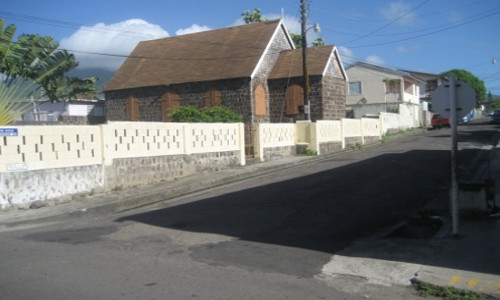
ST. BARNABAS ANGLICAN CHAPEL is a small place of worship on Malone Avenue.
Shortly after Governor Philippe Lonvillier De Poincy arrived in St. Kitts in 1639, he donated the service of fifty enslaved workers for the construction of a very fair Hospital, in a very healthy place, where such sick persons as are unable to effect their recovery at their own houses, are attended, and maintained, and visited by Physitians and Surgeons, till they are restored to their former health. Strangers also who fall sick in the Island are receiv'd in there.
De Poincy was a Knight Hospitaller of the Order of St. John of Jerusalem, Rhodes and Malta. The Order had been engaged in the care and physical well being of pilgrims to the Holy Land from the 11th century. The limited medical knowledge of the time meant that what they offered was mostly a safe haven rather then actual medicine. Although this remained their main objective, they responded to the volatile situation in the Middle East they became a military organisation and along with the Templars, they were the most powerful Christian groups in the region at the time. The early traditions were never abandoned and the Order continued to run hospitals in the places where it was resident. It was this tradition that De Poincy was observing when he built his hospital on land west of College Street. At that time there would not have been any other buildings to obstruct the flow of breezes from the sea, and it was still close to the town.
In 1697 when the Treaty of Ryswick was being negotiated the greatest concern for the English in the Caribbean was the fate of the French parts of St. Kitts which they had occupies since 1690. It was evident that the only hope for peace on the island was to end its division and place it in the hands of one imperial power. However the French were unwilling to give it up and in 1698, Governor Codrington was ordered to restore it to them. The English inhabitants were not happy with this decision and vented their feelings with a wholesale destruction. Codrington pointed out that this had been the French had behaved in a similar manner earlier when they had gained control of the whole island.
It was probably during one of these damaging transitions that the Hospital was destroyed. Eventually the French Huguenots who lived in Basseterre were allowed to build a church on the land it once occupied. Having endured many years of persecution in Catholic France, some had migrated to the Americas, including St. Kitts. De Poincy who had recognised their value as responsible and industrious citizens, had not barred them from settling on the island. Before long there was a small community in St. Kitts. At some point, between 1690 and 1698 when the French part of the island was occupied by the British, the land once occupied by the Hospital was given to the Huguenots who built a small chapel on it. Once again the new structure suffered damage during the French invasion of 1705. In 1713, the Treaty of Utrecht ended the French presence on St. Kitts and in 1726, when the French lands were being sold, the Huguenots petitioned the Committee to be allowed to keep the land and their church. This request was granted.
Over the years the Huguenot community on the island diminished in numbers and was eventually absorbed into the Anglican Church. It is not clear at this point when this change was reflected in the denomination of St Barnabas. Located on the north west corner of Malone Avenue and Fort Thomas Road, the little chapel has a very loyal congregation that prefers the early service there to the more elaborate ones at St. George’s.
Independence Square

INDEPENDENCE SQUARE formerly Pall Mall Square, was renamed on the 19th September 1983 to commemorate the birth of the new nation of St. Christopher and Nevis. It is located on the eastern side of Basseterre bordering on Newtown. Its layout was designed to look like a Union Jack and the streets and houses surrounding it once dated to the mid-eighteenth century. Unfortunately, time and environmental damage have destroyed many of them. Some like the Court House and Public Library have been destroyed by fire and have been rebuilt.
The Square started its life as a pasture on the edge of town. A map of 1714 by Peter Bour, a French Surveyor whom the British employed when the French lands were being sold, shows a pasture just east of Fort Street with houses only on its western side. General William Mathew, who headed the Commission for the sale of the French Lands in 1728 had intended that the Pasture would have been kept for public use. However there was disagreement as to how this should come about.
In 1750, a law was passed to build a court house in the Square and concerns were raised about some individuals who had started to encroach on it from the North, East and South sides of the pasture. . The administration in St. Kitts felt it had every right to use it because of Mathew’s declaration but Gilbert Fleming, his fellow commissioner, and by then the head of Government objected. He reminded the Council and Assembly that all the French lands were deemed to be the private property of the King. He insisted that the Island Administration should either buy the land from His Majesty or ask his permission to build on it. Fleming even offered to pay for the land and donate it to the Administration which then objected that such a move would create obligations on its part. Despite this Fleming went ahead and bought the land and when the Administration refused to deal with him, he sold it to Alexander Home in 1753 and quickly bought it back in 1755. Fleming said that he was willing to sell or donate part of the pasture for the erection of a court house and sell the rest to private business men who would then build their business places there. However the Council and Assembly wanted the whole plot of land to use as a parade ground for the militia. Fleming’s argument that Fort Londonderry was nearby and could be used for parades was not accepted and the administration insisted on acquiring the whole pasture or none at all. On the 19th July 1758, Fleming accepted the offer of £1500 sterling for the land but preferred to move the two buildings he had on it rather than take the offer of £250 sterling that the Administration offered for them. The transaction was concluded on the 24th July 1758.
In January 1792 Webbe Hobson, was charged with finding a good location for the sinking of a well on the pasture. The purpose of the project was the “preservation of the town of Basseterre against fire and for the accommodation of the poor of the parish and for the Negroes of the island.” A subscription was to be taken to pay for the project. The Well was located In the small crescent-shaped piece of land on the southern side of the Square
In 1792, The Government acquire the property called the Tontine located on the South Eastern side of the square. It soon became a significant administrative building housing the offices of the Registrar, the Secretary, the Courts of Justice, the Assembly and the Council. Effectively, this meant that the centre of Administration had shifted from Church Street to the Square. An Auction House was also located in one of the buildings that surround the square but its exact location remains to be discovered.
The author of The West India Sketchbook talks of a slave market in the square where slaves went to sell the produce they grew or things they made. It was a gathering place where slaves actually met to interact with each other, something they looked forward to so much that missionaries had a hard time calling them to church on Sunday which then was market day.
From time to time the square became a parade ground where the militia went through its drills. However, because it was not enclosed and possibly because of the waste that accumulated during and after a market it was an attraction for roaming goats, pigs and dogs.
In 1825 Henry Coleridge, who accompanied his uncle, William Coleridge, Bishop of Barbados during his first visitation to the West Indies and acted as his secretary had a number of recommendations as to how the place could be improved.
In 1834, slavery was officially abolished and was replaced by apprenticeship. The end of apprenticeship in 1838 meant that persons who no longer wanted to work on the plantations could find work elsewhere. The population of Basseterre grew during this period and conditions became crowded. Realising that a clean, steady water supply was essential for a healthy and sanitary environment, the St. Kitts Legislative Council decided to bring pipe-borne water from Olivees into Basseterre in 1855. Penal labour helped to cut the cost of the project. The sum of £50 was placed at the disposal of the Commissioners for the Supply of Water to enable them to carry out the complicated improvements in Pall Mall Square.
When the project was completed a stone fountain was built in the centre of the square to commemorate this significant development. At the summit of the fountain there are three Grecian styled ladies and a small child. Surrounding the circumference of the fountain are lovely flowering plants
In 1872, Henry Booth, the English man who had been commissioned to build the organ at St. George’s, was charmed by the beauty of Pall Mall Square in the bright moonlight. In the 1880s the gardener for the Square was Abraham Brookes. Visitor’s descriptions of it show that it was flourishing into an attractive space that included some horticultural wonders. In 1884 James McQuade, an American visitor recorded his impressions in a book called The Cruise of the Montauk to Bermuda, the West Indies and Florida (New York, Thomas R Knox, 1885). Another American, W. A. Paton in his book Down the Islands (London, Kegan Paul, Trench and Co. 1888) also speaks of a tastefully laid out garden.
By this time, the Square was lit at night with kerosene lamps but these were replaced soon after electricity was introduced in 1928. Security measures during the Second World War included black outs, which meant that street lighting was not be used in order to prevent enemy planes and shipping from getting a bearing on the place. However after the war, the lights around the Square continued to stay off because the power plant then in use could not handle the demand. In 1952, the old plant was replaced by the Needsmust Power Station and the town was again lit at night.
In 1953, L. R. Volonterio, Superintendent of Public Works did much to improve the look of the Square. The paths were bedded with concrete and then surfaced with slabs. The small flower beds and short gravel walks which formerly encircled the fountain were replaced by larger beds intersected by paved walks designed by Volonterio himself. On the north-eastern corner, a 40 year old evergreen, a type of Banyan was removed. It had reached such a size that it covered one-eight of the area of the whole square. Its shade was much enjoyed on sunny days but its low overhanging branches caused some concern especially at night when the reckless took advantage of the lack of visibility to do mischief and some said "jumbies" lurked in its shadow.
A number of prominent persons have lived on the Square at various time. Sir Maurice Davis occupied a house on West Independence Square Street. It is presently a parking place for National Bank. Doris Wall and her family occupied the Georgian house on South Independence Square Street. It was later the home of Professor Bryan King. The house of the water engineer was located on the northern side of the square. Its last occupant in this capacity was Stanley Sebastian. Today the building is abandoned.
In 1995 hurricanes Luis and Marilyn destroyed most of the larger, older trees in the square. These have been replaced with ficus, (Ficus Plantae) and frangipani and other species. One of the most interesting trees which had been planted, was a large Talipot palm near the north-west corner. These palms native to Sri Lanka grow slowly and live for thirty to sixty years flowering once in their lifetimes before dying. Their blades may be up to sixteen feet across and they possess the largest compound inflorescence, or flower head, in the plant kingdom. Once they have flowered, round dark-green fruits fall by the thousands when ripe and then the tree dies. . The one in the Square flowered in 2006.
Today the Square is the venue for many one day cultural events. Although most of the buildings surrounding it have changed from private residences to commercial buildings, many locals and tourists still just sit on new benches which have replaced the old ones and enjoy the lovely new trees which are being replanted. The location remains a calm green space in a town that grows increasingly hot as it attempts to cope with the demands of the 21st century.
National Archives
Government Headquarters
Church Street
Basseterre
St. Kitts, West Indies
Tel: 869-467-1422 | 869-467-1208
Email: NationalArchives@gov.kn
Website: www.nationalarchives.gov.kn
Follow Us on Instagram

